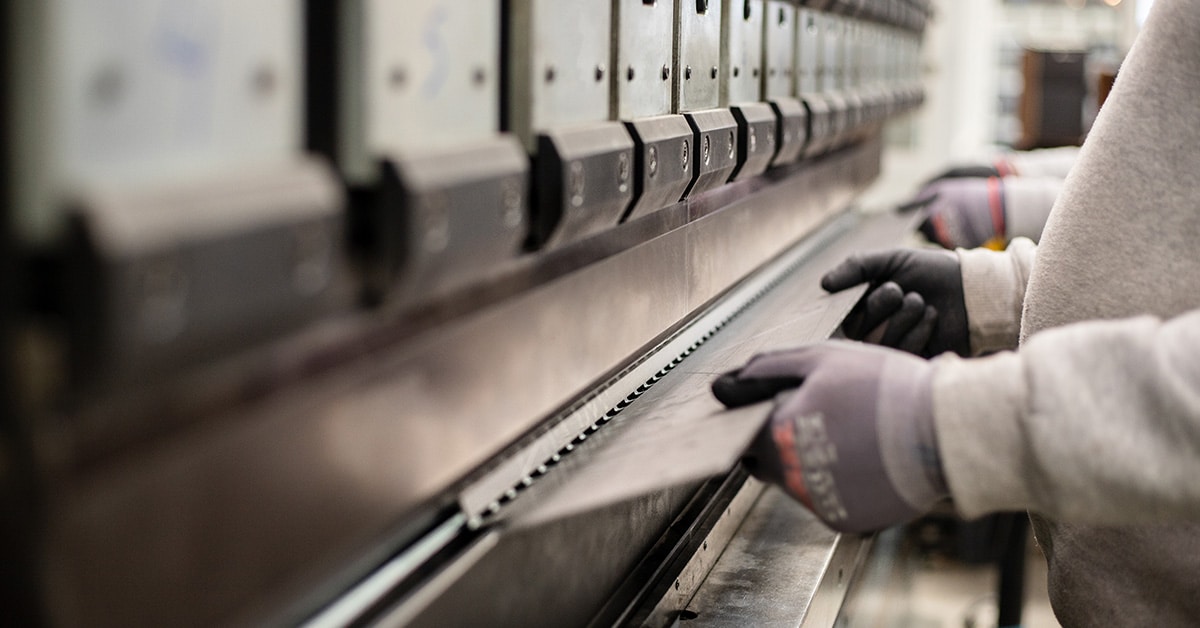It’s easy to think of press brakes for tooling as mere powerhouses, given their primary function is to bend sheet metal. However, modern press brakes are precision equipment that must maintain strict tolerances to ensure the highest-quality finished product. Unaddressed issues within the hydraulic, electrical and other systems can cause significant problems throughout the production line, leading to misalignment, inconsistent bends and even system failure.
These consequences can be devastating for a manufacturer, highlighting the critical importance of industrial press brake maintenance. Proper upkeep of these machines not only prevents manufacturing issues but also ensures a safe and productive workplace for employees. Read on to discover what maintenance teams should do to keep these complex and powerful machines in good working order.
Common maintenance issues with press brakes
If press brake calibration and maintenance are neglected for too long, there’s a good chance the machinery will begin to develop problems. Regular upkeep can prevent some of the most common concerns, such as:
- Hydraulic leaks or pressure fluctuations: This can lead to inconsistent bending force and damage to the press brake’s internal components.
- Misalignment of ram or dies: When the elements that come into contact with the sheet metal are out of alignment, it can result in inaccurate or uneven bends that have a negative impact on the quality of the finished product.
- Electrical and control glitches: Outdated wiring, faulty sensors or software malfunctions may cause the press brake to behave erratically or fail altogether.
- Worn tooling and dies: Long-term usage can dull or deform the dies on a press brake, leading to poor-quality bends.
Press brake maintenance checklist
While maintaining press brakes can be a demanding task, it becomes much more manageable with a checklist that categorizes all the required tasks by their optimal frequency:
Daily/weekly tasks
- Inspect hydraulic fluid levels and top them off if they are below the recommended line.
- Visually inspect the ram alignment to ensure there are no indications of wobbling.
- Clean any metal shavings from the surfaces of the die.
- Ensure that the control panel lights and readouts display no errors.
Monthly/bi-monthly tasks
- Drain and replace hydraulic fluid as recommended by OEM.
- Lubricate guide rails, drive mechanisms and pivot points.
- Inspect belts, gaskets and seals for any signs of cracks or wear.
- Calibrate back gauge to ensure accurate positioning.
Quarterly/seasonal tasks
- Thoroughly test machine safety devices such as light curtains and two-hand controls.
- Evaluate electrical wiring, fuses and circuit boards for signs of overheating or damage.
- Examine tooling dies for signs of wear, and sharpen or replace them as needed to prevent unnecessary press brake die repairs.
Annual tasks
- Conduct a full audit of hydraulic system components including pumps and valves.
- Overhaul or replace worn bearings and bushings.
- Update or re-install machine software or firmware if needed.
- Keep a maintenance log for future reference and compliance purposes.
Hydraulic system care and fluid management
A press brake’s hydraulic system is crucial for ensuring its performance meets all applicable standards. This means maintenance teams need to be vigilant about checking the condition of the hydraulic fluid and correct any issues as soon as they are found. This includes maintaining the correct level of fluid and inspecting it for any signs of discoloration or contamination. Filters should be replaced at OEM-recommended intervals, and fluid coolers should be checked for proper functioning to prevent overheating. Finally, hoses, seals and connections need to be inspected for leaks or signs of pressure drops.
Press brake training and safety
Providing a safe and productive workplace is everyone’s responsibility, which is why manufacturers need to be sure they have a strong protocol in place for operator training and enforcement of safety procedures. Although training new employees is obviously important, manufacturers should also recognize the significance of continuous education for seasoned operators.
Implementing a comprehensive training program for all employees working with press brakes ensures best practices are consistently followed. This proactive approach helps maintain a safe and efficient production floor by minimizing the likelihood of shortcuts or overlooked tasks. Ensuring safe operation of this equipment should start with a focus on these areas:
- Operator certification: New operators should receive formal training as soon as possible and obtain any necessary certifications. This ensures they will know the correct procedures for using the equipment and understand some basic troubleshooting techniques.
- Lockout/tagout (LOTO) procedures: Workers must know how to isolate the equipment from power during press brake repair or maintenance work to prevent potential exposure to high voltage.
- Incident reporting and root cause analysis: Whenever breakdowns or near-misses occur, it’s crucial that operators and maintenance teams know how to report these incidents and perform a thorough analysis to understand what may have caused them to prevent costly press brake machine repair.
Work with the industry leaders in press brake maintenance
Proper press brake maintenance protocols can bring a number of benefits to a manufacturing facility. These include extended machine lifespans, enhanced productivity, minimal unplanned downtime, improved worker safety and higher product quality.
Following the checklist above can serve as the backbone of a successful press brake maintenance plan. Alternatively, manufacturers can turn to ATS to provide comprehensive services for keeping this equipment in good condition. Our experienced team of technicians can provide specialized maintenance, press brake inspections and even worker training to ensure performance meets and exceeds production goals. To learn more about everything ATS can do to keep press brake equipment online for as long as possible, reach out and speak with a member of our team today.






